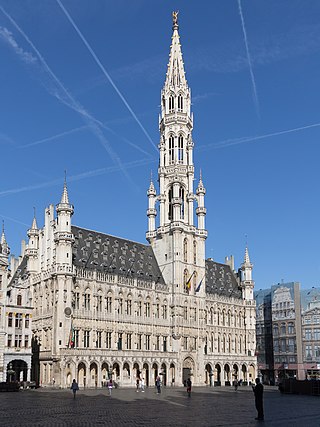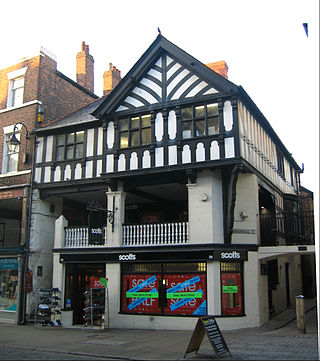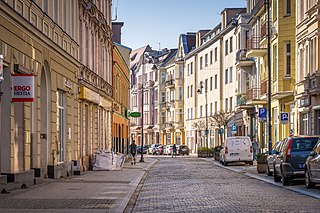
An arch is a curved vertical structure spanning an open space underneath it. Arch can either support the load above it or perform a purely decorative role. The arch dates back to fourth millennium BC, but became popular only after its adoption by the Romans in the 4th century BC.

A dormer is a roofed structure, often containing a window, that projects vertically beyond the plane of a pitched roof. A dormer window is a form of roof window.

An oriel window is a form of bay window which protrudes from the main wall of a building but does not reach to the ground. Supported by corbels, brackets, or similar cantilevers, an oriel window is most commonly found projecting from an upper floor but is also sometimes used on the ground floor.

Tracery is an architectural device by which windows are divided into sections of various proportions by stone bars or ribs of moulding. Most commonly, it refers to the stonework elements that support the glass in a window. The purpose of the device is practical as well as decorative, because the increasingly large windows of Gothic buildings needed maximum support against the wind. The term probably derives from the tracing floors on which the complex patterns of windows were laid out in late Gothic architecture. Tracery can be found on the exterior of buildings as well as the interior.

The Nuremberg Toy Museum in Nuremberg, Bavaria, is a municipal museum, which was founded in 1971. It is considered to be one of the most well known toy museums in the world, depicting the cultural history of toys from antiquity to the present.
This page is a glossary of architecture.

A mashrabiya or mashrabiyya is an architectural element which is characteristic of traditional architecture in the Islamic world and beyond. It is a type of projecting oriel window enclosed with carved wood latticework located on the upper floors of a building, sometimes enhanced with stained glass. It was traditionally used to catch wind and for passive cooling. Jars and basins of water could be placed in it to cause evaporative cooling. It is most commonly used on the street side of the building; however, it may also be used internally on the sahn (courtyard) side. The term mashrabiya is sometimes used of similar lattices elsewhere, for instance in a takhtabush. It is similar to Indian jali.

The Town Hall of the City of Brussels is a landmark building and the seat of the City of Brussels municipality of Brussels, Belgium. It is located on the south side of the famous Grand-Place/Grote Markt, opposite the neo-Gothic King's House or Bread House building, housing the Brussels City Museum.

The Jharokha is a stone window projecting from the wall face of a building, in an upper story, overlooking a street, market, court or any other open space. A common feature in classical Indian architecture, most prominent in Rajasthan. It is supported on two or more brackets or corbelling, has two pillars or pilasters, balustrade and a cupola or pyramidal roof; technically closed by jali but generally partly open for the residents to peep out to see passing processions. The jharokha is more formal and ornamental than English or French oriel window, and is one of the most distinctive characteristics of the façade in medieval Indian architecture until the 19th century.

A four-centred arch or four-centered arch is a low, wide type of arch with a pointed apex. Its structure is achieved by drafting two arcs which rise steeply from each springing point on a small radius, and then turning into two arches with a wide radius and much lower springing point. It is a pointed sub-type of the general flattened depressed arch. This type of arch uses space efficiently and decoratively when used for doorways. It is also employed as a wall decoration in which arcade and window openings form part of the whole decorative surface. Two of the most notable types are known as the Persian arch, which is moderately "depressed" and found in Islamic architecture, and the Tudor arch, which is much flatter and found in English architecture. Another variant, the keel arch, has partially straight rather than curved sides and developed in Fatimid architecture.

Nasseef House or Nassif House is a historical structure in Al-Balad, Jeddah, Saudi Arabia. As of 2009, it is a museum and cultural center which has special exhibits and lectures given by historians.

3–31 Northgate Street is a terrace of shops, offices and a public house on the west side of Northgate Street, Chester, Cheshire, England. All the buildings have a set-back ground floor with a covered walkway, are timber-framed in their upper storeys, and are listed buildings, being graded II* or II. The part of the terrace comprising numbers 5–31 is known as Shoemakers' Row, or Sadler's Row.

The Grosvenor Club and North and South Wales Bank is a building at 47–57 Eastgate Street, Chester, Cheshire, England. It is recorded in the National Heritage List for England as a designated Grade II listed building, and continues to be used as a bank.

30 Bridge Street, Chester is a shop in Chester, Cheshire, England. It stands on a corner on the west side of the street and the south side of Commonhall Street, and contains a section of the Chester Rows. It is recorded in the National Heritage List for England as a designated Grade II listed building.

Dworcowa Street is one of the main streets of Bydgoszcz, in Downtown district. Many of its buildings are registered on Kuyavian-Pomeranian Voivodeship Heritage List.

Śniadecki Street is a street in downtown of Bydgoszcz, Poland. It has an important mercantile concentration.

Pomorska Street is an important street in downtown Bydgoszcz.

The residential architecture in Historic Cairo covers the area that was built during the Fatimid, Ayyubid, Mamluk, Ottoman, French occupation and even Mohamed Ali periods. Historic Cairo covers an area of around 523.66 ha on the eastern bank of the Nile river and is surrounded by the modern quarters of Greater Cairo. First report of activities of Urban Regeneration Project for Historic Cairo set a map to compare the world heritage property and buffer zone in different institutions such as (URHC) & Supreme Council of Antiquities (SCA).

Architecture Of Saudi Arabia was not different in the pre-oil era during the early 1930s from what it was across the past centuries. Construction and building activities followed a simple and modest style back then, as there was a lack of specialized architects in the modern sense. Instead, native communities would erect their own structures manually through the efforts of builders using basic means and local materials in what came to be known as “traditional architecture.” Every region in Saudi Arabia was famous for its own brand of architecture that expressed its artistic taste. Building materials used at that time were sourced from the local environment, such as clay, rock, palm fronds, and wood. Similarly, the architectural styles passed on from generation to generation reflected each region’s climatic and environmental conditions.

The Old Parsonage Museum in Fraserburg is the first parsonage that the Fraserburg Reformed Church, the local congregation of the Dutch Reformed Church in South Africa (NGK), built for its pastor, five years after the congregation's founding in 1851. It has for many years housed the local museum and is one of three national heritage sites in the Karoo town. Its restoration around 1979 was the largest of several projects in the region carried out around that time, including that of the Peperbus, a former Anglican church and gunpowder magazine.






































